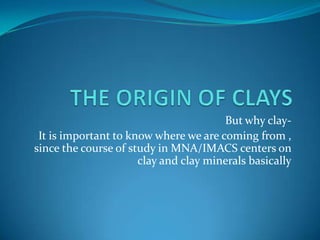
The origin of clay
- 1. But why clay- It is important to know where we are coming from , since the course of study in MNA/IMACS centers on clay and clay minerals basically
- 2. How are clays formed Clays are formed from weathering of silica rich rocks e.g Granite Processes of Formation- -Weathering of the silica rich rock -bedrock weathering -transporting of the weathered rocks -Sedimentary processes -Incorporation of Carbonates
- 3. Requirements - ReactionTime - Igneous Rocks (Intrusive Igneous Rocks) -Geological Factor -Agents of Transportation Agents of Weathering -Alteration of Chemical composition -Pressure -Temperature
- 4. Types of Clays –Based on Origin 1-Residual Clays-not far from parent rock 2-Sedimentary Clays -far from parent material Residual Clay (primary clays)–Non plastic,white,e.g kaolin Sedimentary Clay (secondary clays)- Plastic,grey,darker,smaller paricles and uniform e.g ball clay,fire clay
- 5. Residual clays are formed basically by surface weathering This gives clays in 3 ways -chemical decomposition of rocks -solution of rocks(limestone)containing clayey impurities which are insoluble -disintergration and solution of shales But the most common process of clay formation is the decompostion of feldspar
- 6. SOME INTRUSIVE ROCKS Coarse Grains-slow cooling Clays are not formed from Extrusive rocks
- 7. Diorite
- 8. Granite
- 10. Gabbro
- 11. Mechanisms of clay minerals formation -Inheritance -Neoformation -Transformation The 3 mechanisms operating in 3 geological systems -Weathering -Sedimentary - Diagenetic hydrothermal
- 12. Inheritance Another area reaction Stable Natural deposit Previous stage in rock cycle reaction Dominace in sedimentary environments
- 13. Neoformation Clays precipitation from solution Reaction of amorphous material
- 14. Neoformation Secondary precipitates of calcite , sulphates , Fe Affirmation of permafrost Structural and mineralogical changes are irreversible and affect present soils Understanding of quartenary environment-needs assessment of possible frozen ground
- 15. Transformation Possesion of inherited structure Chemical reactions-ions exchanged and modification of cations (layer transformation) 1)ion exchange between losely bound ion and those of environments 2)layer transformation –modification of arrangement of octahedral, tetrahedral and interlayer cations Dominance in diagenetic-hydrothermal environments
- 16. The best mechanism Layer transformation Result of this type of reaction are better preserved in geological records
- 17. Environment of formation 1)Weathering zone Upper zone of the earth crust –T and P varies Short reaction time 2)Sedimentary environment-long reaction time(sedimentation,subsidence) -near or below sea level Sediment-water interface -low temperature Pressure (1 kb )
- 18. Diagenetic hydrothermal -zones in contact with hot water -wide range of environmental conditions
- 19. Incresing energy required Mechnism/ inheritance neoformatio transformati environment n on s sedimentary weathering Diagenesis- hydrothermal
- 20. CONTROVERSIAL ISSUE OF DETRITAL VS DIAGENESIS ORIGIN OF CLAYS DETRITAL OR DIAGENESIS
- 21. Detrital-reflection of character of source material, inheritance of basic clay mineral lattice Diagenesis-adsorption of cation and its modification
- 22. Application of XRD in Detrital vs Diagenesis controversy -Collection of thousands of samples -to illustrate the variety of clay under similar environmental conditions -variety of environments in which same clay minerals occur
- 23. XRD OF ORGANIC AND PYRITE RICH SHALES -No particular clay mineral is restricted to a particular environments -dominance of kaolinite in fluviate environment -illite ,monmorillionite abundance,frequency,sole clay mineral in all environments -chlorite not a dominant mineral -non marine shales are seldom,if ever monomineralic
- 28. interpretation -clay minerals do not originate from depositional environments -they are detrital in origin -though they are altered(degraded) in fluviate and subaerial environments But little evidence of alteration in major basin of deposition to show that it is a major factor in defining the ultimate mineralogic character of clay
- 29. TYPES OF CLAYS BASED ON GROUPS -KAOLINITE -MONTMORILLIONITE -SMECTITE -ILLITE -CHLORITE
- 30. BASED ON GENERAL COMPOSITION AND PROPERTIES -KAOLIN-consist mainly of kaolinite -BENTONITE-majorly monmorillionite,hardens when mixed with water -BALL CLAY-kaolinite, mica -FIRE CLAY-kaolinite, feoxide,magnesia,alkalines,can resist high temp -COMMON CLAY-no resistance to heat, has impurities than fire clay -ARMENIAN BOLE-attapulgite
- 31. Bibliography Clay mineral formation and transformation in rocks and soils by D.D EBERL , US Geological survey A discussion on the origin of clay minerals in sedimentary rocks by Charles .E Weaver, Shell Oil Co,Houston,Texas Identification of Clay minerals by Xray Diffraction Analysis by George W Brindley The origin of clay minerals in soilsand weathered rocks, www.springer.com Clay types, geologic origins by ARTS 186 Directory
- 32. NOW THAT WE KNOW WHERE WE ARE COMING FROM , WE CAN IDENTIFY WHERE WE ARE GOING TO
- 33. THANKS FOR LISTENING MERCI POUR VOTRE ATTENTION